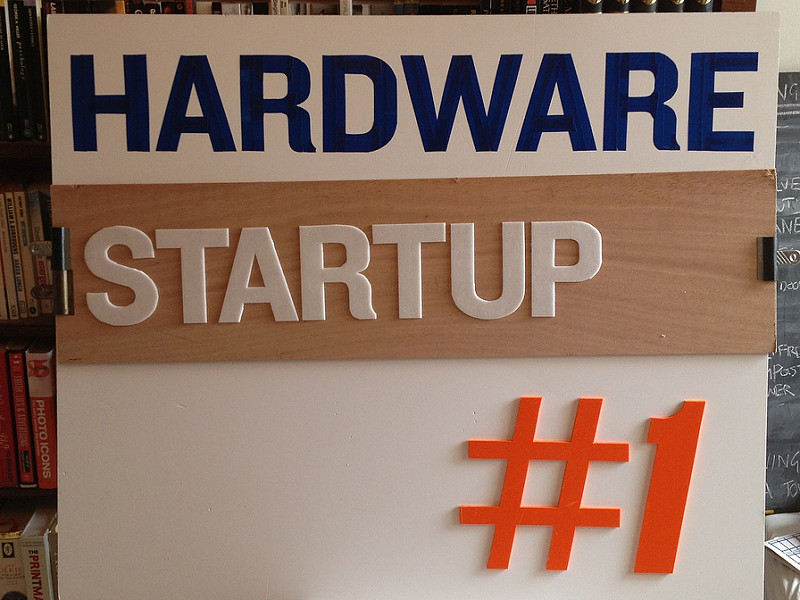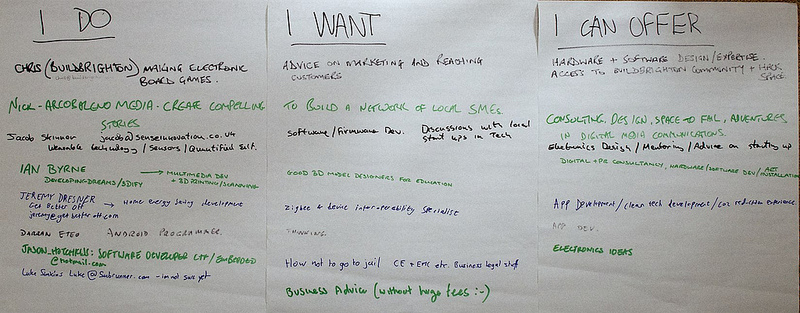Lessons learned from Hardware Startup #1
Hardware Startup is the name for a new experiment I’m running with David Stoughton.
We’re exploring the space where makers become entrepreneurs, when personal projects become commercial products. We’re trying to figure out what kind of community there is in the UK, and how we can help grow it.
There are several groups already running, such as Internet of Things London, Future Manufacturing and Makers Guild. The RSA are also making interesting moves in this area. And there’s the nascent Fablab network. In the US of course, there’s Make Media’s Hardware Innovation Summit, and Maker Pro newsletter.
All of those groups could become partners and collaborators in the future. One key hole that we’re trying to plug (though not the only one), is that none of them happen here, in Brighton.
My ambition is that Hardware Startup could grow to a conference + workshops format (along the lines of dConstruct), or a hardware-focused incubator, or a support and training network like Makers Guild. Or maybe it will take some other form.
Our MVP is a meetup group in Brighton with talks, demos and lightning pitches from the local community. Our thinking is that this gives the community an opportunity to come together, meet and grow. It also helps us learn what the local market is like. Where are people at? What problems do they face? What are they trying to achieve?
We ran our first event on 3 July 2013 at the new Fusebox space in New England House. These are some thoughts on how that went, and what I learned.
Ticket price
We charged £2.50 + Eventbrite fees. I’m glad we did, as it reduced no-shows, and allowed us to pay our speakers’ travel costs. Plus we had enough left over to pay for a domain name and some hosting, so we now have a home on the web: http://hardwarestartup.co.uk
We took payment up-front, which was an accident, as it happens, and added a level of jeopardy to the process. (We’d have to refund everyone manually if we’d decided to cancel, and take the hit on the processing fees.)
Speakers
We were lucky enough to get great speakers. A good range, from achievable to aspirational role models. It may prove hard to sustain this quality level.
Marketing
We had about 30 attendees, which was pretty much our target for this first event. It’s a real effort to build momentum for something like this when you’re starting from scratch. I mostly went through direct contacts: people I knew would be interested, or were involved in similar ventures. There were no breakthrough moments, or noticeable ‘connectors’ that registered an unusual impact on ticket sales.
It was all Twitter and email. We also had the Eventbrite page, and a Lanyrd page, though I’m not sure these did much. For the first event, we didn’t have a website.
To give you an indication of scale, at the time of the first event, we were running at about 40 Twitter followers. Our account was about 3 weeks old.
Event format
We opened the doors at 7pm, and let people arrive and mingle for about 20 minutes. I did a short intro, then we had 4 talks of about 20 minutes each, with 5 minutes after each talk for questions. That left us about 10 minutes at the end for more mingling and chat.
In retrospect, I’d cut it down to 3 talks and allow more time for networking at the end.
WIth such tight timings, you need a good way to indicate to speakers when they’re running out of time. Someone in the front row with a big piece of paper saying ‘5 minutes left’, maybe.
We put out a few bottles of wine to make it more casual, and that was a good idea. The donations cup covered the cost as well. Next time, we need to include some soft drinks and a water jug.
Community development
It’s important that these events aren’t just a passive exchange from the speakers to the audience. We need to know who’s coming, and what they’re interested in. We also need to allow them time to get to know each other, network and exchange ideas.
This time, we had some ‘I want / I can offer’ sheets stuck on the wall, which I asked people to contribute to — and which they did, much to my surprise — and I would do something like this again.
The other thing that will help with this is allowing more time for networking, and maybe having a post-event pub option, to give those who want to continue talking time to do so.
Logistics
It’s like having a house party. You’re standing around in an empty room, and then suddenly 30 people turn up, and it all goes crazy. It really helps to have some people on hand to help getting people into the building, signed in, and so on.
We were lucky to have a team of helpers, including Wired Sussex people, who could help this all run smoothly.
Tech
Luke from Subrunner Sound System very kindly offered his PA to us. Thanks Luke! With 30-35 people, we were just on the edge of needing one. Any more and it would have been a must.
There was the usual faff with the projector and Powerpoint slides beforehand, but thankfully we minimised the between-speaker changeover hassle. I can’t believe how bad this tech still is.
Sustainability
Too early to say. If you kept the same format, and could find a pool of interesting speakers with little effort, you could do this in a manageable amount of spare time. That’s not an option for me though, so we will be looking for financial support.
We also had access to a superb, free venue (The Fusebox), but that will not be free forever, and we’d likely be looking at a £200-300 venue bill for future events. So we need a host organisation who can let us use their space.
Thanks
None of this would have been possible without the help of Luke, Amy, both Toms, Laura and Rosalie from Wired Sussex, our speakers, and participants. Thank you all 🙂


